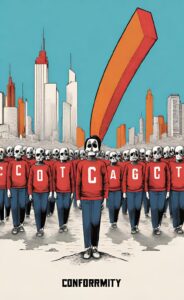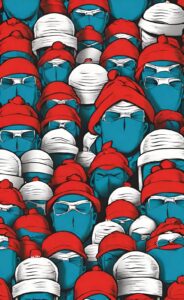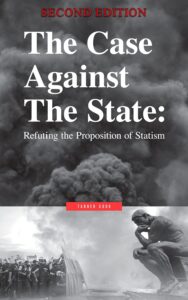In the quest to fit into societal norms and meet conventional standards, many individuals unknowingly stifle their creative abilities and abandon their unique identities. This phenomenon, often termed as ‘Conformity Bias’, has a profound impact on creativity and individualism.
Understanding Conformity Bias and its Effects on Creativity
Conformity bias is an innate tendency wherein we imitate the behaviors and attitudes of those in our group, even if it contradicts our personal insights or creative expressions. This is primarily driven by our inclination to win acceptance from the group, often at the expense of our own innovative thoughts and ideas. Though this inclination might promote unity and cohesion in a group, it often stunts creativity.
Creativity thrives when individuals are allowed the liberty to think freely and present unconventional ideas. Regrettably, conformity bias focuses more on achieving a common viewpoint, thus quelling these original ideas. As a result, the culture of conformity diminishes creativity by undermining the importance of personal ingenuity and unique perspectives. It places consensus on a higher pedestal than the expression of diverse, innovative thoughts.
The Desire to Fit In and the Suppression of Creativity
Our inherent social tendencies often drive us to seek inclusion in groups, paving the way for conformity bias. This desire to fit in can trigger a counterproductive cycle where we suppress our innate creativity to adhere to the norms of the group we aspire to belong to. The fear of isolation and the longing for societal approval can push us to abandon our unique ideas in favor of established patterns and beliefs.
In these circumstances, the focus shifts from exploring and expressing our creative potential to trying to fit into a predetermined mold. This results in not only the dilution of our creative capabilities but also the stifling of our personal growth and individual expression. Consequently, we find ourselves in a position where we are trading our creative sparks and individuality for the comfort of acceptance and group validation.
Conformity Bias in the Workplace: The Killer of Innovation
In professional settings, conformity bias manifests prominently, acting as a significant barrier to creativity and innovation. The emphasis on maintaining uniformity and achieving consensus can create an environment where employees feel compelled to mirror the thinking of the majority, regardless of how it might inhibit new ideas. This propensity towards conformity can stifle the entrepreneurial spirit, thereby throttling the lifeblood of innovation within a company’s culture.
Interestingly, research indicates that organizations that foster an environment of open dialogue and value divergent opinions often outshine their competition in terms of innovation. The destructive power of conformity bias in the workplace underscores the need for a culture that celebrates diversity of thought and encourages its employees to venture beyond the mainstream. The willingness to embrace dissenting opinions, value individual contributions, and encourage unique thought processes, can act as catalysts to spur innovation and ward off the creeping shadows of conformity bias.
Conformity Bias and Individualism: An Unhealthy Relationship
The fundamental clash between conformity bias and individualism significantly undermines creativity and personal expression. Conformity bias places a premium on assimilation and compliance, often stifling our distinct perspectives and hindering creative expression. In contrast, individualism, by nature, is a celebration of uniqueness and promotes creativity. This dichotomy leads to an inherently unstable relationship, wherein the pursuit to conform undermines the essence of individualism.
A major fallout of this conflict is a decline in our creative thinking abilities. When we are driven by the urge to blend in, we often suppress our individuality. The pressure to meet societal expectations and norms and to align with the majority’s viewpoints is overwhelming, thus, compelling us to sideline our unique identities and viewpoints. We are forced to navigate a rigid pathway defined by others, which not only hampers our creative thinking but also curtails our personal growth.
Hence, the interplay between conformity bias and individualism forms a precarious dynamic that is damaging to both our creativity and our personal sense of self. The suppression of individualism at the altar of conformity obstructs the free flow of creative ideas, thus stifling our ability to explore innovative perspectives. This unhealthy relationship underscores the pressing need to encourage individualism, promoting the belief that each person’s distinct voice and creative potential is a valuable asset worth celebrating.



Dangers of Groupthink: How Conformity Bias Affects Decision Making
Groupthink, a common byproduct of conformity bias, dramatically influences decision-making processes. This scenario unfolds when the collective group’s longing for agreement suppresses individuals’ instinct to propose differing options, scrutinize established views, or voice unpopular thoughts.
The aspiration for unanimous agreement overrides critical thinking and stifles creativity, leading to decisions that are often less innovative and potentially flawed. Such an environment discourages creative problem-solving and leads to sub-optimal outcomes, demonstrating how conformity bias can adversely affect both creativity and the quality of decision-making. Groupthink, therefore, stands as a stark illustration of the dangerous repercussions of unchecked conformity bias.
Breaking Free from Conformity: Cultivating Creativity and Individualism
Combatting the detrimental effects of conformity bias necessitates a deep comprehension of its implications on our creativity and sense of individuality. It’s vital to foster environments that champion diversity, appreciate contrasting perspectives, and encourage the freedom of self-expression. This approach helps reduce the prevalence of conformity bias, allowing creativity and individualism to flourish.
As individuals, it’s important that we learn to value our distinct perspectives and innovative ideas, rather than suppressing them for the sake of fitting in. Embracing our unique viewpoints can be an enriching experience that ultimately amplifies our creative potential. We need to cast aside the fear of judgment that often accompanies divergent thinking, and instead, rejoice in the beauty of our individuality and the creative possibilities it brings forth.
Likewise, organizations can play a pivotal role in mitigating the effects of conformity bias. They can do so by promoting a culture that values dissent, encourages open discussions, and recognizes the importance of individual contributions. These elements are instrumental in fostering innovation and driving the organization forward.
In essence, breaking free from the shackles of conformity involves an active commitment to embracing diversity, promoting individualism, and encouraging creativity. By doing so, we not only become better individuals but also contribute to a more innovative community.


















